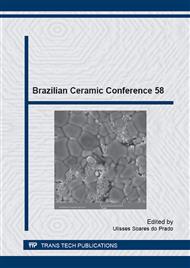p.205
p.213
p.218
p.225
p.231
p.239
p.244
p.250
p.256
The Usage of Ceramics in the Manufacture of the Lining of Temperature Sensors for the Oil Industry
Abstract:
In the oil production, many types of sensors are used in order to monitor some important parameters such as temperature, pressure and flow. These sensors are subjected to harsh operating conditions. Therefore they must present an inert and stable behavior in these conditions. The temperature sensors that are more suited to the oil industry are the Temperature Detectors by Resistance (TDR), because they have high accuracy and wide temperature range. Usually these devices are built with metals as detectors of temperature by encapsulated resistance in inert ceramics. The main objective of this research is to produce new ceramics of a Ca2AlZrO5,5 cubic complex perovskite structure for the encapsulation of temperature sensors. The stoichiometric amounts of the constituent chemicals, with a high degree of purity, are homogenized, through a solid state reaction in a high energy ball mill. They are then compacted by uniaxial pressing and calcined at 1200°C for 24 hours. Soon after, the tablet is crushed giving place to a ceramic powder and the analysis of X-ray diffraction is performed. According to the sintering behavior of the ceramic powder, the microstructure and the homogeneity are studied by the Scanning Electron Microscopy. The results are presented in terms of the potential of this ceramic for applications as components of temperature sensors.
Info:
Periodical:
Pages:
231-236
Citation:
Online since:
June 2015
Keywords:
Price:
Сopyright:
© 2015 Trans Tech Publications Ltd. All Rights Reserved
Share:
Citation:


